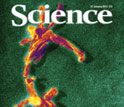News Release 12-015
Researchers Show How New Viruses Evolve, and in Some Cases, Become Deadly

View video
Michigan State researchers show how new viruses evolve, and in some cases, become deadly.
January 26, 2012
View a video with Michigan State University researchers who showed how a new virus evolved potentially dangerous traits.
This material is available primarily for archival purposes. Telephone numbers or other contact information may be out of date; please see current contact information at media contacts.
Researchers at Michigan State University (MSU) have demonstrated how a new virus evolves, shedding light on how easy it can be for diseases to gain dangerous mutations. The findings appear in the current issue of the journal Science.
The scientists showed for the first time how the virus called "Lambda" evolved to find a new way to attack host cells, an innovation that took four mutations to accomplish. This virus infects bacteria, in particular the common E. coli bacterium. Lambda isn't dangerous to humans, but this research demonstrated how viruses evolve complex and potentially deadly new traits, noted Justin Meyer, MSU graduate student, who co-authored the paper with Richard Lenski, MSU Hannah Distinguished Professor of Microbiology and Molecular Genetics.
"We were surprised at first to see Lambda evolve this new function, this ability to attack and enter the cell through a new receptor--and it happened so fast," Meyer said. "But when we re-ran the evolution experiment, we saw the same thing happen over and over."
This paper follows recent news that scientists in the United States and the Netherlands produced a deadly version of bird flu. Even though bird flu is a mere five mutations away from becoming transmissible between humans, it's highly unlikely the virus could naturally obtain all of the beneficial mutations at once. However, it might evolve sequentially, gaining benefits one-by-one, if conditions are favorable at each step, Meyer added.
Through research conducted at BEACON, MSU's National Science Foundation Center for the Study of Evolution in Action, Meyer and his colleagues' ability to duplicate the results implied that adaptation by natural selection, or survival of the fittest, had an important role in the virus' evolution.
Read the full MSU news release here.
Funding for the research was provided in part by NSF and MSU AgBioResearch.
-NSF-
-
The researchers' work is described in the January 27, 2012 issue of the journal Science.
Credit and Larger Version
Media Contacts
Layne Cameron, University Relations, Michigan State University, (517) 353-8819, email: layne.cameron@ur.msu.edu
Principal Investigators
Justin Meyer, BEACON Office, Michigan State University, (517) 884-2561, email: meyerju3@msu.edu
Related Websites
BEACON: http://beacon-center.org/
Michigan State University news release: http://news.msu.edu/story/10262/
The U.S. National Science Foundation propels the nation forward by advancing fundamental research in all fields of science and engineering. NSF supports research and people by providing facilities, instruments and funding to support their ingenuity and sustain the U.S. as a global leader in research and innovation. With a fiscal year 2023 budget of $9.5 billion, NSF funds reach all 50 states through grants to nearly 2,000 colleges, universities and institutions. Each year, NSF receives more than 40,000 competitive proposals and makes about 11,000 new awards. Those awards include support for cooperative research with industry, Arctic and Antarctic research and operations, and U.S. participation in international scientific efforts.
Connect with us online
NSF website: nsf.gov
NSF News: nsf.gov/news
For News Media: nsf.gov/news/newsroom
Statistics: nsf.gov/statistics/
Awards database: nsf.gov/awardsearch/
Follow us on social
Twitter: twitter.com/NSF
Facebook: facebook.com/US.NSF
Instagram: instagram.com/nsfgov



